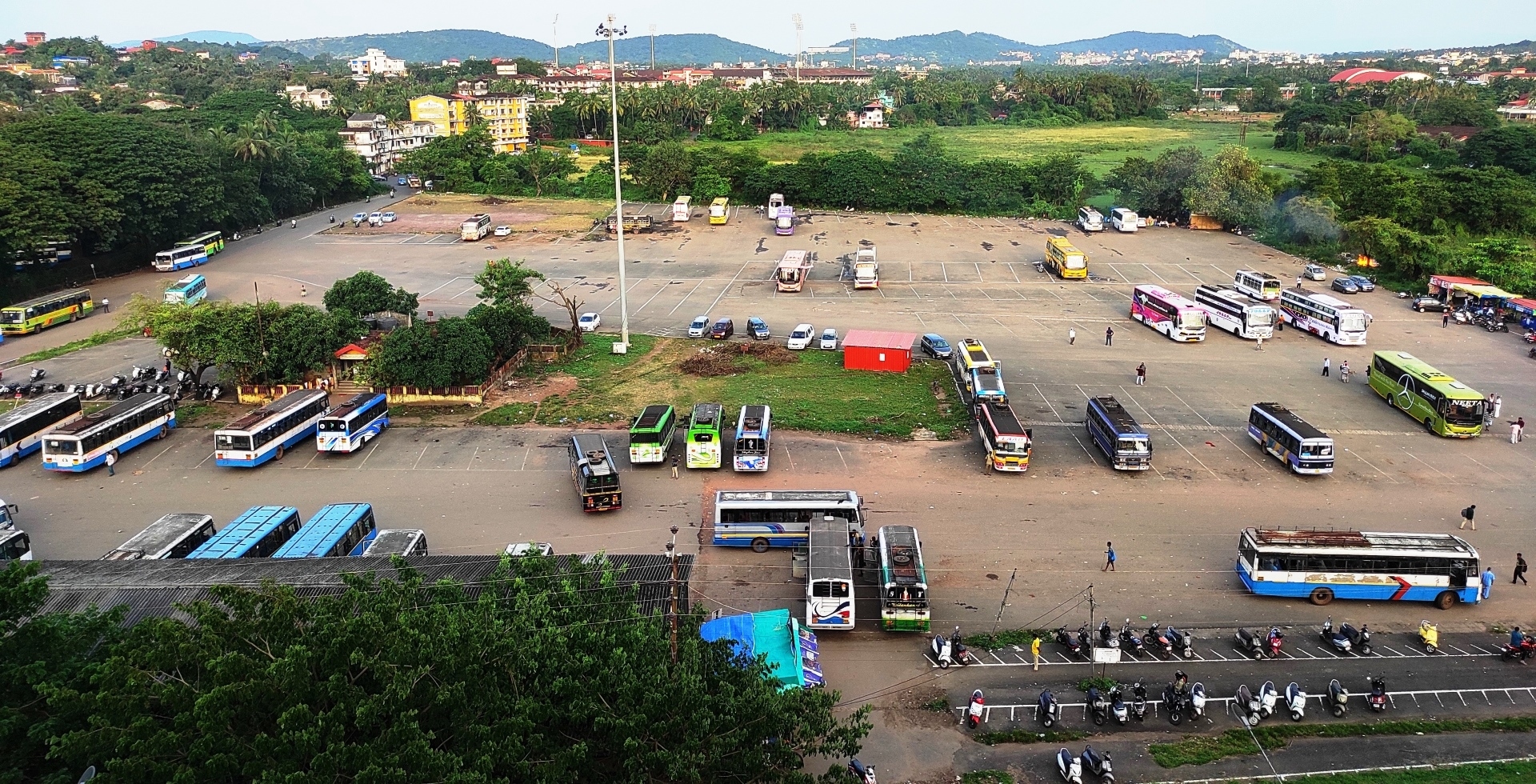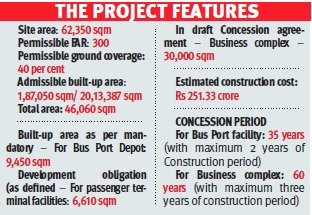Allocation of 30,000 sq mtrs for commercial project raises concern; citizens and commuters question whether project will serve transport needs or become another real estate venture

Land admeasuring 30,0000 sq mtrs of the total 62,350 sq mtrs of land, currently playing host to the existing Margao bus stand is proposed to be allotted to private builders under the PPP mode for commercial exploitation in lieu of building a new Margao bu

MARGAO
As people celebrated Dussehra with religious fervour on Thursday, Madgavkars and Fatordekars alike, besides Saxttikars in general may find themselves asking a pressing question: Will the move to allot 30,000 sq mtrs out of the total 62,350 sq mtrs of land at the KTC bus stand in Margao, with a 300 FAR, for commercial use under a Public-Private Partnership (PPP) model truly serve the purpose of building a modern bus terminus?
It was on a Dussehra day nearly 14 years ago, in the year 2011, that then Chief Minister and current PWD Minister Digambar Kamat laid the foundation stone for an ambitious, ultra-modern bus terminus in Margao. However, the project failed to take off following Kamat’s exit from the government in 2012. Much water had flown down the River Sal since then. The BJP government under then Chief Minister late Manohar Parrikar did try to revive the project around 2017-18 at the insistence of Fatorda MLA and Goa Forward chief Vijai Sardesai, who was then a coalition partner in the BJP regime.
Now, the latest proposal by the BJP-led government to revive the plan under the PPP model has become a hot topic in both political and local circles. The reason isn’t difficult to discern. There are growing concerns that the development may prioritise commercial interests — allowing 30,000 sq mtrs of prime land with a 300 FAR to be utilised for commercial ventures, including shopping malls — potentially defeating the very purpose of creating a functional, modern bus terminal for the city.
The government may have to grapple with a host of questions over the move to develop the bus stand with private party participation under the PPP mode. One, will the development of the bus stand cater to the present as well as long-term requirements of commuters, or will the move to allot prime land admeasuring 30,000 sq mtrs of the prime bus stand property to private players for commercial utilisation defeat the purpose of a spacious bus stand?
That’s not all. Are bus commuters from Margao, Fatorda, Salcete or down South or the local transport stakeholders, including rickshaw and motorcycle pilots, besides taxi operators looking forward for shopping malls, hotels and other commercial enterprise on the sprawling land or are they in favour of a modest bus stand with amenities for commuters, including parking, etc.
Questions are further asked whether citizens of Margao, Fatorda and the transport stakeholders were taken in the loop or the plan placed in public domain before the Transport Department floated the tender inviting bids from prospective bidders to take up the project under the PPP mode. Why were public suggestions and objections not invited by the Transport Department to seek inputs and feedback from citizens and the stakeholders when a staggering 30,000 sq mtrs of prime land will be awarded to the private party for commercial exploitation?
Key questions remain unanswered over PPP model
Many questions remain unanswered about the government’s decision to adopt the Public-Private Partnership (PPP) model for the proposed Margao bus stand project. Concerns are mounting in various quarters that the commercial exploitation of Transport Department land may restrict future expansion and defeat the purpose of creating a modern, future-ready transport hub.
“When land is a scarce commodity, every effort should be made to ensure its optimal and efficient use,” remarked a regular bus commuter. “Has the proposed bus stand accounted for roadside parking of buses across the commercial capital? Is there any provision in the project for designated bus parking areas with nominal parking fees?”
He further pointed out that hundreds of commuters use the Margao bus stand daily to travel to various destinations, including Panaji. Many of them currently park their two-wheelers on the Margao Municipal Council (MMC) land opposite the bus stand.
“Has the Transport Department considered integrating proper two-wheeler parking within the new bus stand premises, keeping in mind the growing number of daily commuters and future needs?” he questioned.
As the debate continues, citizens and stakeholders are calling for transparency, public consultation, and a holistic approach to planning—one that prioritizes transportation needs over real estate interests.
Fatorda MLA objects to redevelopment proposal without public consultation
MARGAO: Fatorda MLA Vijai Sardesai has strongly objected to the proposed Margao bus stand redevelopment project, criticising the manner in which the Transport Department has advanced the plan without adequate public consultation or local representation.
Sardesai reiterated that the project, in its current form, will not see the light of day unless the government places the proposal in the public domain for open discussion and scrutiny. “The Margao bus stand technically falls within the Fatorda constituency,” he pointed out. “Yet, the government didn’t even have the courtesy to inform, let alone involve, the local MLA before floating the tender. This is totally unacceptable,” he added.
Highlighting several shortcomings in the tender documents, Sardesai said the government appears more focused on commercial exploitation than on addressing the core objective of creating a modern and efficient transportation hub. “A glance at the tender reveals the true intention — to prioritise the development of shopping malls and hotels,” he alleged. “In the process, the fundamental purpose of building a bus terminal to meet the growing transportation needs of Margao, Salcete, and South Goa will be completely undermined,” he added.
He further raised concerns over the allocation of 30,000 sq mtrs of prime land — with a high Floor Area Ratio (FAR) of 300 — for commercial use by a private developer, suggesting that the value the developer stands to gain far exceeds the cost of constructing the bus stand itself. “The developer isn’t merely getting land in exchange for building a bus stand; with 300 FAR, the commercial returns will be manifold,” Sardesai asserted.
He confirmed that he has already communicated his concerns directly to Chief Minister Pramod Sawant and is awaiting a response. “I am calling on the government to initiate an interactive exercise with citizens and stakeholders,” he said. “If this does not happen, the people of Fatorda will not allow the project to proceed in its current form.”
PWD Minister calls for caution; supports public consultations
MARGAO: Public Works Department (PWD) Minister Digambar Kamat has urged caution before moving forward with the proposed Margao bus stand project. He has come out in support of holding consultations with experts, professionals, and stakeholders before any final decision is taken.
Kamat, who was Chief Minister when the foundation stone for the ultra-modern bus terminus was laid in 2011, emphasised the need for comprehensive planning, stating that a master plan must be developed for the area surrounding the bus stand to ensure proper infrastructure and long-term viability. “Given the magnitude of the project, a master plan is essential,” Kamat said. “The project must be designed to meet both current and future needs of the commuters.”
While expressing openness to the involvement of private entities under the Public-Private Partnership (PPP) model, Kamat made it clear that the core focus must remain on creating a full-fledged and efficient bus terminal. “I don’t mind if private players are brought in to execute the project,” he noted, ‘but the emphasis must be on building a modern bus stand that caters to today’s needs and anticipates tomorrow’s challenges,” he asserted.
Kamat made these remarks when asked about reports suggesting that the Transport Department plans to allot 30,000 sq mtrs of prime land — with a high FAR of 300 —for commercial development by a private party as part of the project.
“I haven’t yet reviewed the full details of the proposal,” he admitted. “But I strongly believe such a significant project should be discussed in depth with experts, technical professionals, and all relevant stakeholders”, he added.